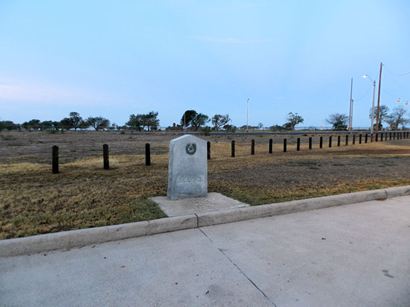|
|
Texas
history is filled with stories of heroism and dedication to duty.
During those dark days of the Texas Revolution many men came forward
and represented themselves well in the war with Mexico. When we think
of those times, the names Travis, Houston,
Austin, Bowie,
and Crockett quickly come to mind. There were many others, however,
who were just as important to the Texas cause.
One of those was Erastus "Deaf" Smith. If he was around today we might
call him, a "Yankee." You see, Deaf was from New York state — but
there was none more dedicated in the Texas fight for freedom than
this man. Although he lost his hearing due to a disease at the age
of 11, Smith never seemed to let this impairment stop him from serving
the people of Texas.
Deaf Smith settled near San
Antonio in 1821. He married a Mexican widow, Guadalupe Ruiz Durán,
in 1822. The couple had four children, all daughters. In 1825, Smith
moved to DeWitt's colony and settled on land about a mile west of
Gonzales. According
to “The Handbook of Texas,” Gonzales
was considered the first American settlement west of the Colorado
River at that time.
At
the outbreak of the Texas Revolution, Smith's loyalties were apparently
divided. He considered himself a Mexican citizen and he had a great
love for the Mexican people. Some say that he joined the Texans only
because a Mexican sentry refused to allow him to enter San
Antonio to visit his family. The town was under siege by Stephen
F. Austin's army at the time and, in his anger, Smith joined that
group. The Texans were, no doubt, glad to have him.
It seems that the Mexican citizens of San
Antonio had a fondness for Deaf Smith. They probably kept him
well informed of the temperament and ability of the soldiers defending
the city. He reported that the troops of Gen. Martin Perfecto de Cos
were "disaffected to the cause they are serving." Because of his steady
source of information and his detailed reports, Deaf Smith soon became
know as the number one spy for the Texas army.
On
December 8, 1835, Deaf Smith guided the Texas troops into San
Antonio. He was shot on that day while on the rooftop of the Veramendi
Palace. Ben Milam was killed
at the door of that structure at about the same time. Although Smith
was severely wounded, he remained with the army. According to his
leaders, Smith was "well known to the army for his vigilance and meritorious
acts." They also said that his services as a spy could not be equaled
by anyone.
After he recovered from his wounds, Deaf Smith became a messenger
for William B. Travis at the Alamo.
Travis called Smith, "The bravest of the brave in the cause of Texas."
Smith was away from the Alamo
delivering letters from Travis to Sam
Houston when the Mexican army made its final assault.
Houston sent
Smith back to San Antonio
to learn the status of the garrison there. It is obvious just how
much Houston trusted
the ability of Deaf Smith. In a report to Thomas Jefferson Rusk, Houston
wrote: "If living, [Smith] will return with the truth and all important
news." Smith did return to Gonzales
with some of the Alamo survivors — these included Susanna
Dickinson and her baby daughter, Angelina.
At
the battle
of San Jacinto, Deaf Smith again performed his duty without regard
for his personal safety. He captured a Mexican courier who was carrying
important dispatches for Gen. Santa Anna. These documents gave Houston
information on the strength of the enemy and when Santa Anna might
be reinforced. On April 21, 1836, Smith was ordered by Houston
to destroy Vince's Bridge and cut off any hope of escape by the Mexican
army (or anyone else).
Deaf Smith's service to Texas went far and beyond the call of duty.
While he was at San Jacinto, his family was living in Columbia,
Texas. The war had left them penniless. On November 11, 1836,
the Texas Congress granted Smith the property of Ramón Músquiz on
the northeast corner of San
Antonio's Military Plaza as a reward for his service to the army.
Nevertheless, Smith and his family remained in Columbia.
Although
he resigned his commission in the army, Smith went on to organize
and command a company of Texas Rangers. On February 17, 1837, this
group defeated a band of Mexicans at Laredo.
This was to be Deaf Smith's final battle. He left the rangers and
moved to Richmond,
Texas. He died there, at the home of Randal Jones, on November
30, 1837.
Sam Houston was
devastated at the passing of Smith. In a letter written to Anna Raguet,
Houston wrote:
"My friend Deaf Smith, and my stay in darkest hour, is no more!!!
A man, more brave, and honest never lived. His soul is with God, but
his fame and his family, must command the care of his country!"
I don't believe Erastus (Deaf) Smith was a man who really sought fame.
He apparently had a great love for his family and country. I wonder
if the course of Texas history would have been different — if that
Mexican sentry had allowed him to visit his family during the siege
of San Antonio. |
 |
Deaf
Smith Centennial Marker at the entrance to the Lake Casa Blanca International
State Park in Laredo
Photo courtesy Barclay
Gibson, September 2011 |
|
|
